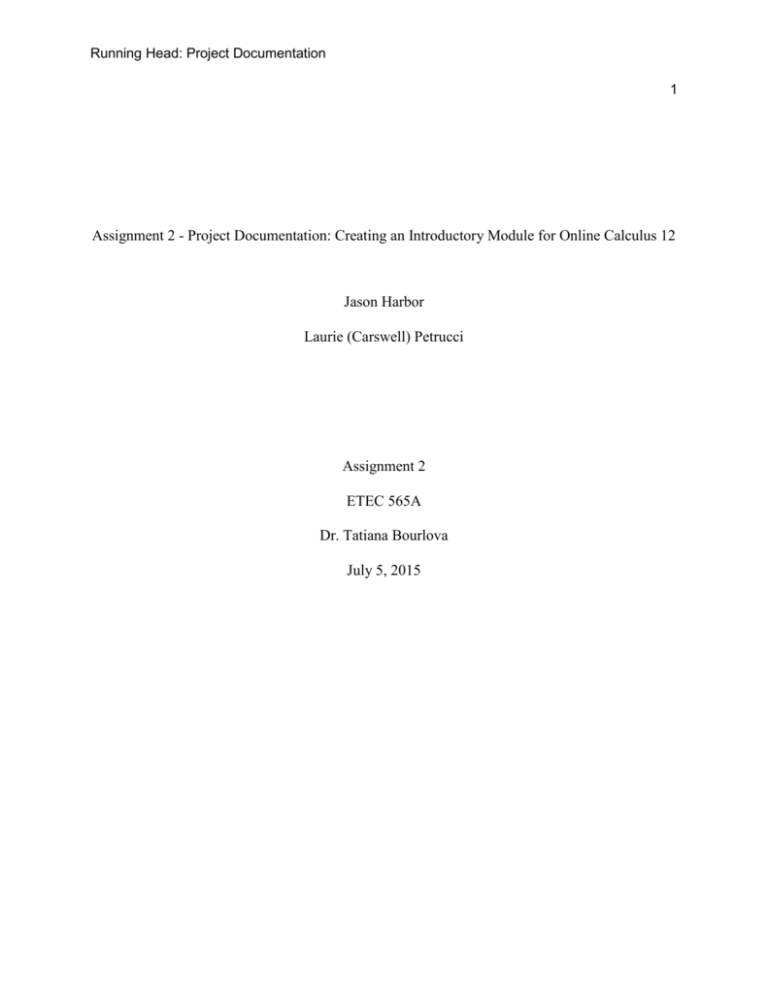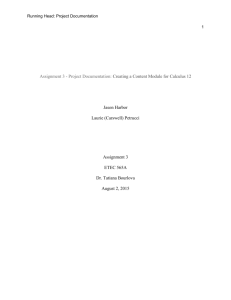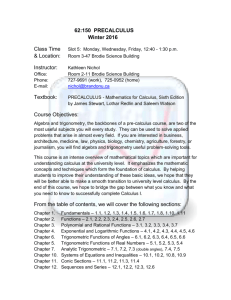ETEC 565 Assigt2 ProDoc Petrucci
advertisement

Running Head: Project Documentation 1 Assignment 2 - Project Documentation: Creating an Introductory Module for Online Calculus 12 Jason Harbor Laurie (Carswell) Petrucci Assignment 2 ETEC 565A Dr. Tatiana Bourlova July 5, 2015 Running Head: Project Documentation 2 Theme Our group will be developing an online Introductory Module for Calculus 12 using Moodle as the Learning Management System (LMS). We will be exploring how to build a course within an LMS and integrate multimedia tools in order to create an interactive and engaging online course for students. We will guided by three central pedagogical frameworks of learning 1) creating a student-centred learning environment (SCLE), 2) creating technology that is sound in pedagogy, content and knowledge (TPCK), and 3) incorporating collaborative tools to foster a social learning environment. As well, we will base our prescribed learning outcomes as outlined by the Saskatchewan Ministry of Education (Saskatchewan Ministry of Education 2012). Jonassen & Land (2012) state, “SCLE’s provide access to shared information and knowledge building tools to help learners to collaboratively construct socially shared knowledge.” (p. 96). As well, Donovan et al. (2005) advocate that “Student-centred Learning Environment (SCLE’s) draws out and builds on student thinking” when knowledge construction tools and conversation tools are incorporated into the learning environment. In addition, we will be building our module within a Technological Pedagogical Content Knowledge (TPCK) framework to enhance both our learning regarding developing an online course and our students’ learning regarding the content of the online course. Niess (2005) investigated pre-service teachers’ pedagogical content knowledge (PCK) development with respect to integrating technology and concluded that “for technology to become an integral component or tool for learning, science and mathematics pre-service teachers must also develop an overarching conception of their subject matter with respect to technology and what it means to teach with technology—a technology PCK (TPCK)” (p. 510). Running Head: Project Documentation 3 We will also take a Vygotskian approach in creating a social and collaborative learning environment. John-Steiner & Mahn (1996) state “Sociocultural approaches emphasize the interdependence of social and individual processes in the construction of knowledge.” (p.191). From a Vygotskian perspective, John-Steiner & Mahn (1996) “view learning as distributed, interactive, contextual, and the result of the learners' participation in a community of practice.” (p. 204). Rationale “It is becoming increasingly clear that merely introducing technology to the educational process is not enough to ensure technology integration since technology alone does not lead to change” (Carr, Jonassen, Litzinger & Marra, 1998). It is necessary to develop an effective learning environment that is grounded in sound pedagogy, content and knowledge-building. Becoming fluent with educational technology means teachers must go beyond mere competence with the latest tools (Zhao, 2003). In fact, teachers must find meaningful and authentic ways of integrating the tools into their daily practice. A recent article was published in the Washington Post highlighting blended learning options and the author concluded, “If blended learning is to lead to positive outcomes for students, then it must be highly relational, active and inquiry oriented (both online and offline), and commit to empowering students with digital tools.” (Strauss, 2015). In order for students to benefit from an online delivery model rather than a face-to-face model, they must actively engage in their learning. Students actively engage in learning differently in an online classroom versus a face-to-face classroom. Therefore, it is essential that our group consider what in pedagogically effective in an online course and incorporate learning tools that maximize the affordances of online learning. Richardson (2000) states “the unique characteristics that define Running Head: Project Documentation 4 online learning (appropriate combinations of asynchronous and synchronous voice, text, and video) can actually lead to enhanced or hyper communications.” The keys to creating a student-centred learning environment involve allowing students to bring their own interests to the learning, build on what they know, and correct misconceptions in their learning. This involves using collaborative tools such as blogs/discussion boards, email, video creation and live chats. While text is important, our group will strive against creating an online textbook, instead we will work to create an interactive learning digital tool. We will also need to integrate knowledge construction tools to support learning in a mathematical student-centred learning environment. Jonassen & Land (2012) highlight “complexity of problem calls on skills that are not in learners repertoires necessary to scaffold activities and cognitive skills” (p. 96) To support students in scaffolding activities, we will need to integrate digital tools that help students organize their ideas, be able to access model representations, and access conversation tools to receive expert help from the instructor in addition to material provided in lessons. It is important for students to participate in dialogue and have access to communication tools instead of only having access to pre-recorded audios for example, as “research suggests that the use of this type of lecture recorded technology, as a primary approach to learning, can result in students falling behind in the curriculum (Gosper et al. 2008). As well, we will capitalize on the ability for students to access an ever-growing content base of knowledge stored on the Internet, “Not only is access to technology increasing, but access to an ever-growing body of content is also increasing” (Anderson, 2008, p. 53). We will also be able to build a more interactive module using web-based resources, “The Web is quickly changing from a context defined by text content and interactions to one in which all forms of Running Head: Project Documentation 5 media are supported.” (Anderson, 2008, p. 53). To accomplish this, we will create a repository of resources (such as Khan Academy among others) in addition to our own so that students may experience the content from other perspectives Assessment tools are also necessary in creating effective learning environments: Quality online learning provides many opportunities for assessment – opportunities that involve the teacher, but also ones that exploit the influence and expertise of peers and external experts, others that use simple and complex machine algorithms to assess student learning, and perhaps most importantly, those that encourage learners to reflectively assess their own learning (Anderson, 2008. p.49). Therefore, we will be cognizant of integrating various tools that allow students to demonstrate their learning through a variety of methods including both individual and group assignments. “The enhanced communication capacity of online learning, as well as the focus of most adult online learning in the real world of work, however, provide good opportunities to create assessment activities that are project-based,” (Anderson, 2008. p. 50). Accordingly, SCLE’s, “draws out and builds on student thinking” (Donovan, 2005. p. 242). Overall, the assessment tools that we integrated into the LMS Module will allow the instructor to address the following areas outlined by Bates (2014): 1) to improve and extend students’ learning, 2) assess students’ knowledge and competence in terms of desired learning goals and outcomes, 3) to provide the teacher/instructor with feedback on the effectiveness of their teaching and how it might be improved. Learning Objectives Running Head: Project Documentation 6 Following the completion of the Introductory Module, students will be to…. ● contact either or both instructor(s) about questions regarding the course in an effective manner, as described in the introductory module ● follow course procedures and understand the structure that the course will follow ● understand the various aspects of assessment and evaluation that will be undertaken by both the students and the teachers throughout the course ● complete the introductory survey ● complete the expectations and norms assignment, and adhere to these expectations throughout the course ● complete the test assignment and upload multiple files into a single assignment shell Functionality of its elements 1. Our Calculus 12 Moodle course contains the following module structure and sections: A. Welcome to Calculus 12! a. Welcome messages from both instructors b. Instructor contact information and office hours c. News Forum - allows for discussion threads to be created. For the introductory module, we have created four discussion threads to begin the course: i. Questions about the course: ii. Connection with your classmates iii. Student Lounge iv. Welcome to Calculus 12! Running Head: Project Documentation 7 B. Course Information a. Course Calendar b. Course Procedures c. Syllabus d. Assessment and Evaluation e. Outcomes and Indicators C. Course Introduction a. Getting to Know You b. Expectations and Norms c. Tutorial: How to Submit Assignments d. Test Assignment D. Learning Modules a. Unit 1 - Background Concepts: Algebra concepts necessary for success at calculus b. Unit 2 - Functions: How are functions necessary to understand calculus? c. Unit 3 - Limits & Continuity: What is a limit? Why is continuity important? d. Unit 4 - Differentiation: The derivative of a function is a powerful tool e. Unit 5 - Curve Sketching: By applying the derivative we can sketch the graph of nearly any function f. Unit 6 - Derivative Applications: The derivative can be applied to many different real-life scenarios g. Unit 7 - Transcendental Functions: We can take the derivative of more than just algebraic functions h. Unit 8 - Integration: The integral provides a great deal of information about a function E. Resources: online tutorial support, YouTube links, Q & A page: a. Khan Academy - Online tutorial resource, b. LearnNowBC c. GeoGebra - Online tutorial resource, Running Head: Project Documentation 8 d. YouTube - Big Picture of Calculus, e. Frequently Asked Q & A about Calculus 12 course 2. Assessment methods/tools, A. Assignments and Projects - both summative and formative B. Summative Unit Exams C. Weekly Quizzes - All quizzes are considered formative assessment and will be openbook. D. Final Exam 3. Communication methods/tools, A. Students will use the News Forum to collaboratively share their learning B. Students have also been asked to post questions to each other, as well as the instructor, if they need further clarification to understand concepts. C. Students are encouraged to use Firefox as a browser, as this browser is most compatible with Moodle. 4. Types of content A. Welcome messages in video format B. jpeg images of instructors in the connecting to classmates discussion thread C. Internet links to provide students additional tutorial support D. YouTube links to extend student learning E. Calendar with important dates for students F. Moodle activity options - pages, URL’s, assignments, video upload, news forum G. Tutorial on how to submit assignments H. Online quizzes and surveys 5. Elements of design A. Adhered to a common colour palette for text and banner. Running Head: Project Documentation 9 B. We minimized the amount of text visible on the course site. Instead, we added resources and activities to hold course content. C. Included a Wordle banner to add both visual appeal and visual references to key terminology that students will experience throughout the course. Resources ● Met weekly using Google Hangouts. ● Evenly distributed tasks to complete with deadlines that were mutually decided on. ● Decided to create a Moodle site that included both of as instructors. By building a joint site, we thought it would provide more opportunities for greater numbers of students to participate. After reading Trinh's case study, it was very apparent that one teacher can not handle a course load of 150 students. However if Moodle courses are shared by a group of teachers who are available at different times, course management will be easier and allow the teachers the ability to better focus on helping students with content rather than dealing with course logistical issues. Running Head: Project Documentation 10 References Anderson, T. (2008a). Towards a theory of online learning. In T. Anderson & F. Elloumi (Eds.), Theory and practice of online learning. Edmonton AB: Athabasca University. Bates, A. (1991). Interactivity as a criterion for media selection in distance education. Never Too Far, 16, p 5–9. Bates. T. (2014). Appendix 8. Assessment of Learning. Teaching in a Digital Age. Bransford, D., Brown, A.L., & Cocking, R. R. (2002). How people learn: Brain, mind, experience, and school. Washington, DC: The National Academies Press. Carr, A. A., Jonassen, D. H., Litzinger, M. E., & Marra, R. M. (1998). Good ideas to foment educational revolution: The role of systematic change in advancing situated learning, constructivism, and feminist pedagogy. Educational Technology, 38(1), 5-14. Donovan, M. Suzanne, & Bransford, John D. (Eds.). (2005). How Students Learn: History, Mathematics, and Science in the Classroom. Washington D.C.: Division of Behavioral Running Head: Project Documentation 11 and Social Sciences and Education, The National Academies Press. Finkelstein, N. D., Adams, W. K., Keller, C. J., Kohl, P. B., Perkins, K. K., Podolefsky, N. S. (2005). When learning about the real world is better done virtually: A study of substituting computer simulations for laboratory equipment. Physical Review Special Topics - Physics Education Research, 1(1). doi: 10.1103/PhysRevSTPER.1.010103 Gosper, M., D. Green, M. McNeill, R. Phillips, G. Preston and K. Woo. (2008). Final report: the impact of web-based lecture technologies on current and future practices in learning and teaching. Sydney: Macquarie University. Horn, M. B., and H. Staker. (2011). “The Rise of K–12 Blended Learning.” Clayton Christensen Institute website. http://www.christenseninstitute.org/wp-content/uploads/2013/04/The-rise-of-K-12blended-learning.pdf John-Steiner, V & Mahn, H. (1996). Sociocultural approaches to learning and development: a vygotskian framework. Educational Psychologist, 31, 191-206. Jonassen, David, & Land, Susan (Eds.). (2012). Theoretical Foundations of Learning Environments (2nd ed.). New York, NY: Routledge. Koehler, Matthew J., & Mishra, Punya. (2005). What happens when teachers design educational Technology? the development of technological pedagogical content knowledge. Journal of Educational Computing Research, 32(2), 131-152. Niess, M. L. (2005). Preparing teachers to teach science and mathematics with technology: developing a technology pedagogical content knowledge. Teaching and Teacher Education, 21, 509-523. Richardson, J. (2000). Researching student learning: Approaches to studying in campus-based Running Head: Project Documentation 12 and distance education. Buckingham, UK: Open University Press. Saskatchewan Ministry of Education (2012). Calculus 30. Retrieved July 3, 2015 from https://www.edonline.sk.ca/bbcswebdav/library/curricula/English/Mathematics/Calculus3 0_2012.pdf Strauss, V. (2015). Blended learning: The great new thing or the great new hype? Washington Post. Retrieved from http://www.washingtonpost.com/blogs/answersheet/wp/2015/06/21/blended-learning-the-great-new-thing-or-the-great-new-hype/ Zhao, Y. (Ed.). (2003). What teachers should know about technology: Perspectives and practices. Greenwich, CT: Information Age Publishing.



